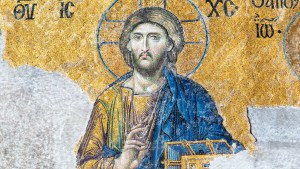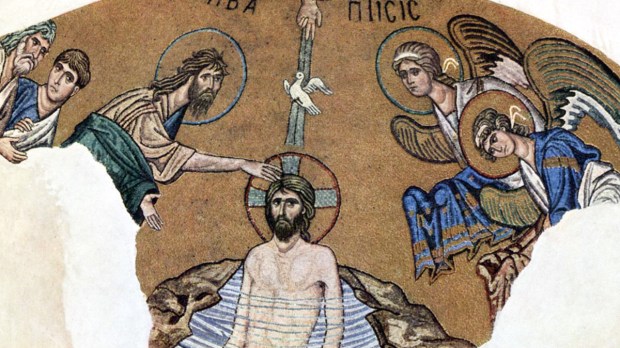The three synoptic gospels (that is, those of Matthew, Mark and Luke) describe the baptism of Christ in detail. Matthew’s version reads:
Then Jesus came from Galilee to John at the Jordan, to be baptized by him. John would have prevented him, saying, “I need to be baptized by you, and do you come to me?” But Jesus answered him, “Let it be so now; for it is proper for us in this way to fulfill all righteousness.” Then he consented. And when Jesus had been baptized, just as he came up from the water, suddenly the heavens were opened to him and he saw the Spirit of God descending like a dove and alighting on him. And a voice from heaven said, “This is my Son, the Beloved, with whom I am well pleased.”
Matthew 3:13-17
This passage is known as the Epiphany (or the Theophany) of the Holy Trinity – the word epiphany being Greek for “revelation,” thus implying Jesus’ baptism is a “revelation of God,” an event in which God reveals himself.
Several paradoxes stem from this revealing character of the event, as Icon Reader points out.
To begin with, Jesus Christ is revealed as the Son of God the moment he submits to a mere man – John the Baptist. But John returns the gesture and, even though he is the one baptizing Jesus, in most of these baptism icons we find him bent over in reverence. In some others, the Baptist is shown as beholding the miracle of the Theophany, his head looking up to the open heavens.
The baptism of Christ: “The sea saw and fled, the Jordan turned back”
In the icons of the baptism of Christ, even though Jesus “came from Galilee to the Jordan to be baptized by John,” John does not occupy the center stage. Elements of John’s preaching are, however, always found in these icons. For example, a tree with an axe lying at its root echoes the Baptist’s preaching: “Even now the ax is lying at the root of the trees; every tree therefore that does not bear good fruit is cut down and thrown into the fire.” (Mt 3:10). On the opposite bank of the river (John is almost always depicted as standing in the left bank), angels contemplate the newly baptized Christ.
The center of the icon is entirely devoted to the moment of revelation itself. Jesus is not submerged in the Jordan but rather standing up, as wide as the river itself. The paradox of John’s authority (“I need to be baptized by you, and do you come to me?”) is here solved through hand gestures – as is often the case in icons. Whereas in most Western art Jesus’ hands are held together in prayer (as if highlighting Jesus’ decision to “fulfill all righteousness” by submitting to the Baptist’s authority), in Orthodox icons Jesus’ hands are shown in a sign of blessing – much like that shown in Pantocrator icons.
This is where devilish sea monsters make their appearance. It is not that the waters of the river Jordan are “cleansing” the baptized Christ, but the other way around. Christ’s blessing cleanses the waters themselves. That is the reason why little sea creatures appear to be fleeing from Christ’s feet in most theophany icons – also referring to Psalm 114:3, “the sea saw and fled, the Jordan turned back.”



